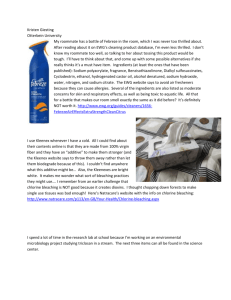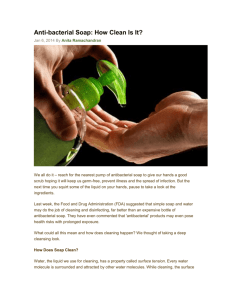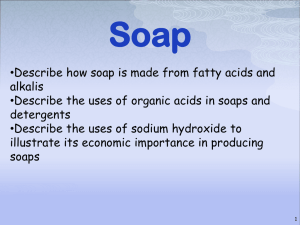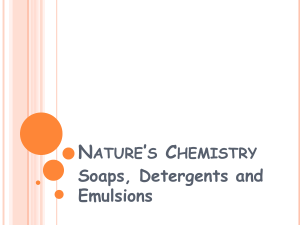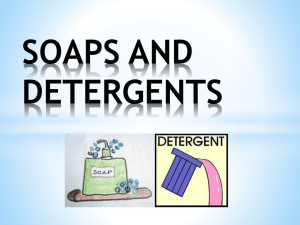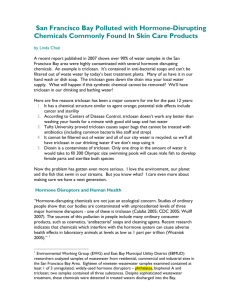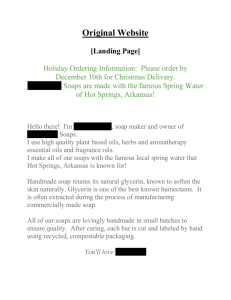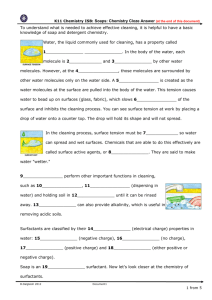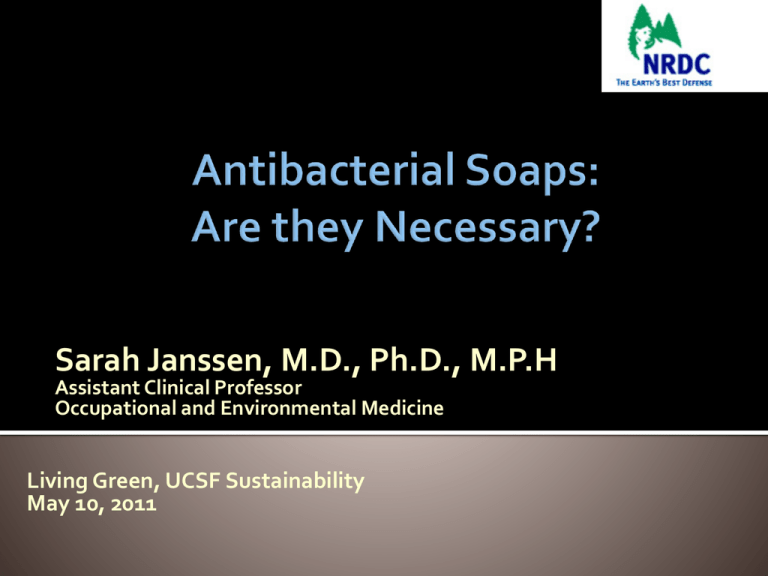
Sarah Janssen, M.D., Ph.D., M.P.H
Assistant Clinical Professor
Occupational and Environmental Medicine
Living Green, UCSF Sustainability
May 10, 2011
Regulated by the FDA through the Federal Food, Drug,
and Cosmetic Act (“Food and Drug Act”) prohibiting the
marketing of drugs unless they are found to be safe and
effective.
1974. 1st Proposal To Establish a Monograph
for OTC Topical Antimicrobial Products
1978 Tentative final order
1994 Amended Tentative final order
2010 Working on new amendments to
proposed final rule
I. Conditions under which antimicrobial
products are generally recognized as safe and
effective and are not misbranded.
II. Conditions under which antimicrobial products
are not generally recognized as safe and
effective or are misbranded.
III. Conditions for which the available data are
insufficient to permit final classification at this
time.
Isopropyl Alcohol, >70% (I)
Povidone-iodine, 5-10% (I)
Hexachlorophene (II)
Chloroxylenol (PCMX) (III)
Quaternary ammonium compounds
Benzalkonium chloride (III)
Benzethonium chloride (III)
Triclosan, <1% (III)
Chlorhexidine gluconate, 2 or 4% (ns)
Alcohol (I)
Chloroxylenol (PCMX) (III)
Quaternary ammonium compounds –
Benzalkonium chloride (III)
Benzethonium chloride (III)
Triclocarban (III)
Triclosan (III)
Triclosan – 75% liquid hand soaps.
Triclocarban - >25% of bar soaps
“ At this time, FDA does not have evidence
that triclosan added to antibacterial soaps and
body washes provides extra health benefits
over soap and water.”
“It is FDA’s opinion that exisiting data raise
valid concerns about the effects of repetitive
daily human exposure to these antiseptic
agents.”
Absorbed across the skin, mucosa.
Half life 11-12 hours.
Found in >75% Americans surveyed by the CDC,
exposure increasing (Calafat, EHP, 2008)
Volunteers brushing with triclosan toothpaste for 14
days, had dramatic rise in blood levels (average
450x). (Allymr, 2009)
No more effective than plain soap and water.
• Community intervention studies, no significant
reduction in viral or bacterial disease (Aiello, 2007)
Not effective against Gram negative bacteria
Fatal hospital outbreak Pseudomonas
contamination of triclosan soap dispsenser,
(Lanini, 2006)
Associated with outbreak of S. marsecens in SICU
(Barry, 1984)
Potential to promote drug-resistant bacteria
Triclosan-resistant bacteria isolated from
residential and feedlot soil (Welsch, 2011)
Studies show cross-resistance to ≥1 antibiotic for at
least 1 bacteria species (Aiello, 2007)
E. coli, Salmonella enterica, Staph. aureus
Amp, Chl, Cipro, Ery, INH, Tet
Thryoid disruptor, decreases thyroxine levels
(Crofton, 2007)
Interferes with testosterone synthesis,
decrease sperm counts (Kumar, 2009)
Interferes with estrogen action, earlier onset
of puberty (Stoker, 2010)
Found primarily in bar soaps, some liquid
Also rapidly absorbed across skin (Schebb,2011)
No more effective than plain soap and water
(Aiello, 2007)
Potential to promote drug-resistant bacteria
Capable of entering the food chain
Unique Endocrine disruptor
No activity alone
Amplifies activity of endogenous steroid
hormones (Ahn, 2008)
Amplifies testosterone activity, increases male
accessory sex organ weight (Chen, 2008)
(Wu, ES&T, 2010)
Antibacterial soaps:
Are they necessary?
IA. Strongly recommended for implementation and strongly
supported by well-designed experimental, clinical, or
epidemiologic studies.
IB. Strongly recommended for implementation and supported
by certain experimental, clinical, or epidemiologic studies
and a strong theoretical rationale.
IC. Required for implementation, as mandated by federal or
state regulation or standard.
II. Suggested for implementation and supported by suggestive
clinical or epidemiologic studies or a theoretical rationale.
No recommendation. Unresolved issue. Practices for which
insufficient evidence or no consensus regarding efficacy
exist.
1.
When hands are visibly dirty or contaminated with
proteinaceous material or are visibly soiled with blood
or other body fluids, wash hands with either a nonantimicrobial soap and water or an antimicrobial soap
and water. (IA)
2. If hands are not visibly soiled, use an alcohol-based
hand rub for routinely decontaminating hands in all
other clinical situations described in items 1C–J. (IA)
(Morbidity and Mortality Weekly Report. Recommendations and Reports
October 25, 2002 / Vol. 51 / No. RR-16 available at:
http://www.cdc.gov/mmwr/PDF/rr/rr5116.pdf)
“Alcohol-based products are more effective for standard
handwashing or hand antisepsis by HCWs than soap
or antimicrobial soaps.”
3. Provide personnel with efficacious hand-hygiene
products that have low irritancy potential, particularly
when these products are used multiple times per shift.
(IB)
4. Provide HCWs with hand lotions or creams to
minimize the occurrence of irritant contact dermatitis
associated with hand antisepsis or handwashing. (IA)
5. To maximize acceptance of hand-hygiene products by
HCWs, solicit input from these employees regarding
the feel, fragrance, and skin tolerance of any products
under consideration. The cost of handhygiene
products should not be the primary factor
influencing product selection (IB)
6. Do not add soap to a partially empty soap dispenser.
This practice of “topping off” dispensers can lead to
bacterial contamination of soap (IA)
(Morbidity and Mortality Weekly Report. Recommendations and Reports
October 25, 2002 / Vol. 51 / No. RR-16, available at:
http://www.cdc.gov/mmwr/PDF/rr/rr5116.pdf)
Use plain soap and water
Alcohol –based hand sanitizers
Avoid buying other products impregnated
with antimicrobials
Read labels
Organic food ?
Kaiser Permanente
Eliminated the use of triclosan hand soaps in all
facilities, public and patient care areas.
Also doesn’t recommend the use of antimicrobial
impregnated fabrics, paints, carpets or building
materials because of unproven effectiveness and
higher costs
Natural Resources Defense Council
www.nrdc.org
NRDC fact sheet on triclosan
Available for download at:
www.nrdc.org/health/files/antimicrobials.pdf

